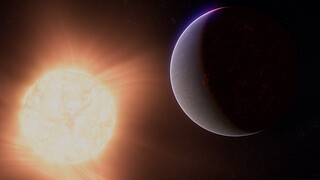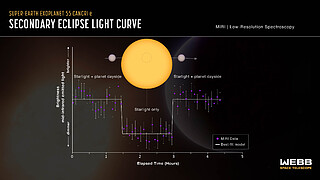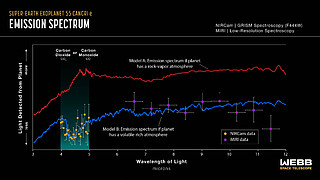weic2412 — Science Release
Webb hints at possible atmosphere surrounding rocky exoplanet
8 May 2024
Researchers using the NASA/ESA/CSA James Webb Space Telescope may have detected atmospheric gases surrounding 55 Cancri e, a hot rocky exoplanet 41 light-years from Earth. This is the best evidence to date for the existence of a rocky planet atmosphere outside our Solar System.
Renyu Hu from NASA’s Jet Propulsion Laboratory (JPL) in Pasadena, California, USA, is the lead author of a paper published today in Nature. “Webb is pushing the frontiers of exoplanet characterisation to rocky planets,” Hu said. “It is truly enabling a new type of science.”
Super-hot super-Earth 55 Cancri e
55 Cancri e is one of five known planets orbiting a Sun-like star in the constellation Cancer. With a diameter nearly twice that of Earth and a density slightly greater, the planet is classified as a super-Earth: larger than Earth, smaller than Neptune, and likely similar in composition to the rocky planets in our Solar System.
To describe 55 Cancri e as rocky, however, could give the wrong impression. The planet orbits so close to its star (about 2.25 million kilometres, or one twenty-fifth of the distance between Mercury and the Sun) that its surface is likely to be molten – a bubbling ocean of magma. In such a tight orbit, the planet is also likely to be tidally locked, with a dayside that faces the star at all times and a nightside in perpetual darkness.
In spite of numerous observations since it was discovered to transit in 2011, the question of whether or not 55 Cancri e has an atmosphere – or even could have one, given its high temperature and the continuous onslaught of stellar radiation and wind from its star – has gone unanswered.
“I’ve worked on this planet for more than a decade,” said Diana Dragomir, an exoplanet researcher at the University of New Mexico in the USA and a co-author of the study. “It’s been really frustrating that none of the observations we’ve been getting have robustly solved these mysteries. I am thrilled that we are finally getting some answers!”
Unlike gas-giant atmospheres, which are relatively easy to spot (the first was detected by the NASA/ESA Hubble Space Telescope more than two decades ago), thinner and denser atmospheres surrounding rocky planets have remained elusive.
Previous studies of 55 Cancri e using data from NASA’s now-retired Spitzer Space Telescope suggested the presence of a substantial atmosphere rich in volatiles (molecules that occur in gas form on Earth) like oxygen, nitrogen, and carbon dioxide. But researchers could not rule out another possibility: that the planet is bare, save for a tenuous shroud of vaporised rock, rich in elements like silicon, iron, aluminium, and calcium. “The planet is so hot that some of the molten rock should evaporate,” explained Hu.
Measuring subtle variations in infrared colours
To distinguish between the two possibilities, the team used Webb’s NIRCam (Near-Infrared Camera) and MIRI (Mid-Infrared Instrument) to measure 4- to 12-micron infrared light coming from the planet.
Although Webb cannot capture a direct image of 55 Cancri e, it can measure subtle changes in the light from the whole system as the planet orbits the star.
By subtracting the brightness during the secondary eclipse, when the planet is behind the star (starlight only), from the brightness when the planet is right beside the star (light from the star and planet combined), the team was able to calculate the amount of various wavelengths of infrared light coming from the dayside of the planet.
This method, known as secondary eclipse spectroscopy, is similar to that used by other research teams to search for atmospheres on other rocky exoplanets, like TRAPPIST-1 b.
Cooler than expected
The first indication that 55 Cancri e could have a substantial atmosphere came from temperature measurements based on its thermal emission, the heat energy given off in the form of infrared light. If the planet is covered in dark molten rock with a thin veil of vaporised rock, or has no atmosphere at all, the dayside should be around 2200 degrees Celsius.
“Instead, the MIRI data showed a relatively low temperature of about 1540 degrees Celsius,” said Hu. “This is a very strong indication that energy is being distributed from the dayside to the nightside, most likely by a volatile-rich atmosphere.” While currents of lava can carry some heat around to the nightside, they cannot move it efficiently enough to explain the cooling effect.
When the team looked at the NIRCam data, they saw patterns consistent with a volatile-rich atmosphere. “We see evidence of a dip in the spectrum between 4 and 5 microns — less of this light is reaching the telescope,” explained co-author Aaron Bello-Arufe, also from JPL. “This suggests the presence of an atmosphere containing carbon monoxide or carbon dioxide, both of which absorb these wavelengths of light.” A planet with no atmosphere or only vaporised rock in an atmosphere would not have this specific spectral feature.
“This is exciting news,” said co-author Yamila Miguel from Leiden Observatory and the Netherlands Institute for Space Research (SRON), both in the Netherlands. “We’ve spent the last ten years modelling different scenarios, trying to imagine what this world might look like. Finally getting some confirmation of our work is priceless!”
Bubbling magma ocean
The team thinks that the gases blanketing 55 Cancri e would be bubbling out from the interior, rather than being present since the planet’s formation. “The primary atmosphere would be long gone because of the high temperature and intense radiation from the star,” said Bello-Arufe. “This would be a secondary atmosphere that is continuously replenished by the magma ocean. Magma is not only crystals and liquid rock, there’s a lot of dissolved gas in it, too.”
In all likelihood, any atmosphere surrounding the planet would be more complex and quite variable as a result of interactions with the magma ocean. In addition to carbon monoxide or carbon dioxide, there could be gases like nitrogen, water vapour, sulphur dioxide, some vaporised rock, and even short-lived clouds made of tiny droplets of lava condensed from the air.
While 55 Cancri e is far too hot to be habitable, researchers think it could provide a unique window for studying interactions between the atmospheres, surfaces and interiors of rocky planets, and perhaps provide insights into the early Earth, Venus and Mars, which are thought to have been covered in magma oceans in the past. “Ultimately, we want to understand what conditions make it possible for a rocky planet to sustain a gas-rich atmosphere, a key ingredient for a habitable planet,” said Hu.
This research was conducted as part of Webb’s General Observers (GO) Program 1952. Analysis of additional secondary eclipse observations of 55 Cancri e are currently in progress. In the future, the team hopes to capture a full phase curve with Webb in order to map temperature differences from one side of the planet to the other, to get a better sense of the planet’s weather, climate and more detailed atmospheric conditions.
More information
Webb is the largest, most powerful telescope ever launched into space. Under an international collaboration agreement, ESA provided the telescope’s launch service, using the Ariane 5 launch vehicle. Working with partners, ESA was responsible for the development and qualification of Ariane 5 adaptations for the Webb mission and for the procurement of the launch service by Arianespace. ESA also provided the workhorse spectrograph NIRSpec and 50% of the mid-infrared instrument MIRI, which was designed and built by a consortium of nationally funded European Institutes (The MIRI European Consortium) in partnership with JPL and the University of Arizona.
Webb is an international partnership between NASA, ESA and the Canadian Space Agency (CSA).
Image Credit: NASA, ESA, CSA, R. Crawford (STScI)
Links
Contacts
Bethany Downer
ESA/Webb Chief Science Communications Officer
Email: [email protected]
Ninja Menning
ESA Newsroom and Media Relations Office
Email: [email protected]
About the Release
| Release No.: | weic2412 | |
|---|---|---|





